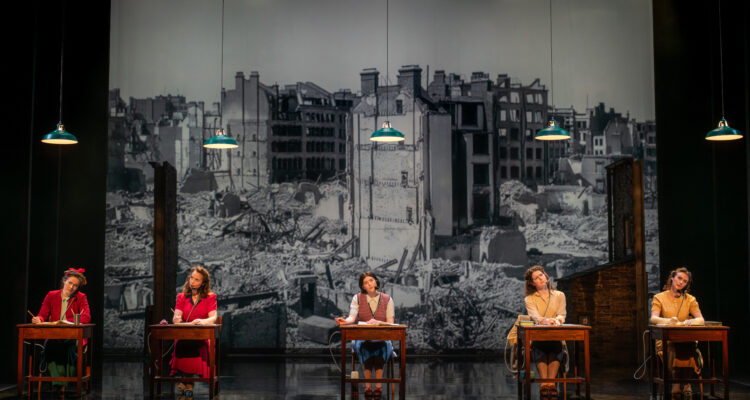Fire destroys. But it can also be a renewing force. For the five young women at the heart of The Girls of Slender Means, the fires of the Second World War have certainly wrought destruction, but they offer up the hope of renewal as well. The play has been smartly adapted with great sensitivity by Gabriel Quigley from Muriel Spark’s 1963 novel of the same name. It follows the five titular ‘girls of slender means’, who are making their way living together in a London boarding house in the immediate aftermath of the Second World War.
The war has brought relative freedoms and opportunities for Jane, Selina, Jo, Anne and Pauline, as it did for so many women. Playing key roles in military intelligence, healthcare and post-war recovery, women had been offered a vision of a world where their raison d’être could be something other than getting married and having children. With the end of the war – and seemingly a return to pre-war norms – the protagonists suddenly find themselves uncertain about who they are and what they could be.
Between them, Quigley and director Roxana Silbert delicately unpick and illustrate this. A delightfully staged scene shows the five girls at their work as secretaries in various government departments, dutifully putting callers through to their uniformly male bosses while working between themselves to solve various social problems. It is no accident that when Jane (Molly Vevers) wants an outfit to go out in, instead of wearing the glamorous Elsa Schiaparelli gown the five girls share, she dons her father’s masculine old dinner jacket, now fashionably tailored for the female figure.
Quigley draws out the clear contemporary references between the 1963 original and today as well. Politicians are decried for putting political doctrine ahead of the problems people face. Lies have become the new truth. The health service is on its knees, although at least in 1945 there was the excuse of six years of war and the promise of a shiny new national health service to come.
Starting with a writer as sharp and acerbic and Spark must bring its own challenges for adaptation, and Quigley does excellently to pull the novel into a theatrical form without losing any of the original wit. The writing remains riotously funny when it needs to be – with some hair-curling innuendo – but in the second half morphs into something darker and more solemn.
Particularly successful is the depiction of the five girls. Quigley fleshes them all out as fully rounded, sympathetic characters, each with their own scars (physical or psychological) from the war. Julia Brown is delightfully acerbic and waspish as Selina, with brittleness hiding her obvious pain beneath. However, it is Molly Vevers as central character (and surely Muriel Spark analogue) Jane who most grips the attention, delivering a compelling portrait of a woman working out who she is in a new world order.
Only Nicholas feels thinly drawn, and about as three-dimensional as one of the mannequins that stand in for the other male characters. However, he works as a catalyst for the story and the audience’s way into the May of Teck Club where the girls live. The production slightly loses its way in the chaotic final scene, but the previous two hours have been such a glorious success that this is easy to forgive.
Adapted by Gabriel Quigley from the novel by Muriel Spark
Directed by Roxana Silbert
Cast: Julia Brown, Seamus Dillane, Amy Kennedy, Molly McGrath, Molly Vevers, Shannon Watson
Runs until Saturday 4 May
19:30 Tuesday-Saturday, 14:30 Saturdays and Wednesdays
2 hours 20 minutes including interval

